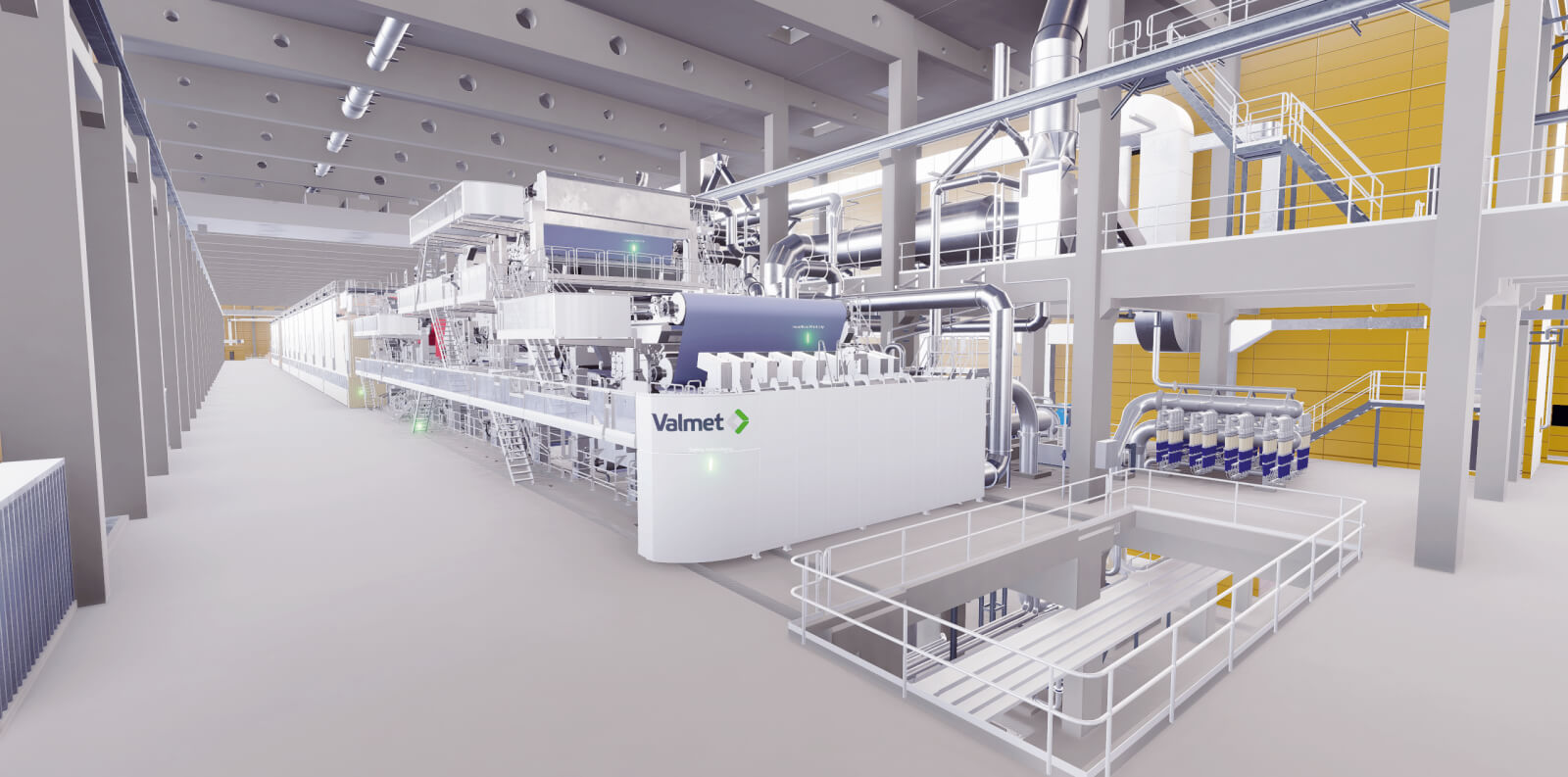05/01/2022
Virtual Mill: New opportunities for plant design, training and maintenance with virtual models
Virtual models of production plants offer significant benefits at all stages of a plant’s lifecycle. From the visualisation of a plant design to streamline the construction process to a digital twin serving alongside an operational plant, the immersive experience utilising a VR headset allow the user to dive into the environment created by the 3D model in a realistic way. VR is particularly well suited for training, as virtual training is safer and more costeffective than training in the physical environment, while still offering a hands-on approach to learning.
Elomatic’s Visualisation services have been involved in the development of the Valmet Virtual Mill concept which assists Valmet’s customers in the presentation of a machine line, in design reviews as well as in various personnel training activities. Delivering a digital twin alongside a board and paper machine to the customer allows Valmet to offer a new range of digital services and innovations by complementing the Valmet Industrial Internet offering. The Virtual Mill is a digital twin of the entire factory in which the user can move freely, get acquainted with the processes and practise various maintenance operations using VR technology.
Virtualisation brings new opportunities to maintenance
In paper mills and other production plants, downtime is known to be an expensive affair. Maintenance must be on top of its game, which means quick response and efficient operation so that all maintenance operations can be completed on time. Digitalisation has been able to provide many tools with which efficient service and maintenance planning can be achieved. The collection and analysis of real-time data has succeeded in streamlining operations in many plants. Proactive maintenance and remote monitoring are activities that would not be profitable without the digital solutions enabling them.
These new possibilities can be further developed through virtual models. Where digitalisation creates data, virtualisation is able to bring the environment described by the digital data under examination as well using a 3D model. In this way, the environment described by the data can be presented to individuals in a visual way that promotes the internalisation of information. The virtual 3D model can be used, for example, to train maintenance in the implementation of a pre-planned measure. Alternatively, situations detected by remote monitoring can be communicated effectively to employees in the field who react to them. Solutions like the Virtual Mill, that use the same base 3D model, can be utilised for installation, commissioning or assembly training.
Virtual models streamline production plant design and construction
Time to market is also a key challenge in setting up new industrial production plants. Virtual solutions are useful and complementary to digital solutions against this challenge as well. Current 3D design models enable the creation of virtual environments already during the construction phase of the plant. Thus, training can begin before the production line is even up and running, which streamlines the start-up and commissioning of the plant once it is completed. Different perspectives can be considered already in the reviews during the design of the plant. For example, the locations of service hatches, the interchangeability of large parts, and the safety of maintenance procedures are easier to illustrate in a real-size virtual environment, and it can help prevent additional costly alterations during construction. 3D models can be used when discussing and planning for the placement and installation of different equipment to quickly build consensus. Feedback related to control rooms and other working environments in the operational phase can be collected as these can be clearly visualised using virtual models. All of this streamlines the construction of production plants and speeds up their start-up.
Virtual models as a competitive advantage
VR, or virtual reality, offers many benefits for utilising 3D models. Immersive experiences utilising VR headsets allow the user to dive into the environment created by the 3D model in a realistic way. The 3D models can be exported to the customer’s actual scanned environment, allowing the 3D model to be viewed in its relevant context. Or, if necessary, the environment can be removed, allowing the user to fully focus on the displayed material in a way that is memorable and easy to understand regardless of 3D perception.
Although VR technology is relatively new, its functionality has been strongly verified. The flexible, scalable and secure way of presenting technical entities using VR is also superior in terms of cost-effectiveness, and the same goes for training. This is especially true when the alternative is using a huge production plant tied to a physical location, which is preferably always operating at full capacity. It is also possible to access the virtual environment anytime and anywhere, without travel or COVID-19 restrictions.
VR is particularly well suited for training activities. Learning by doing and the effect of immersion on concentration speed up training compared to other forms of e-learning. In addition to its cost-effectiveness, training in a VR environment is also safe compared to the physical alternative. For example, working in ATEX environments can be practised virtually in which case the mistakes made are not fatal. These features provide huge benefits in training utilising VR technology.
When purchasing large and complex systems, VR enables the rapid internalisation of technical information, which helps the buyer in decision-making. Examining the equipment and familiarising themselves with the production principles of the production plants from the support processes to the maintenance measures before making a purchase decision help the customer understand exactly what they are purchasing. Content based on design models is reliable, and key functions can be visualised in more detail with animations. Properly constructed, the various contents serve to train the customer, operators and maintenance personnel.
Design models in the field using AR
AR, i.e., augmented reality, and VR are often presented side by side, but there are significant differences in their uses. In general, VR is best suited for off-site pre-planning measures. AR, in turn, allows 3D data to be imported directly into the operating environment, allowing the same 3D content to be used directly in the field. The information content may be exactly the same, but the creative utilisation of AR in the field creates completely new opportunities for utilising design models.
Information necessary for maintenance can be brought on-site in an AR-assisted manner at a scale of 1:1 to physical reality for just the right need and place in the form of manuals, 3D design models or signs. For example, a 3D animation of maintenance procedures can be brought as a full-size model to the exact location where the physical maintenance procedure is performed. In this way, the person performing the maintenance procedure can see on site the order in which the maintenance will be performed and what other factors should be taken into account during the maintenance.
When used in sales, AR can be used to place a product in the right place before the purchase decision is made and to ascertain the extent of the change or the whole of the procurement that has to be made. If the product or component is assigned to an old factory, AR can assist in the examination of the product’s transport and assembly. Possible problems caused by the delivery of the product are easily detected, as are the changes to the current process. This helps with preparing for complications already at the purchase stage. By adding instructions on the installation procedures to the content, the installation can also be planned in detail on site in advance. When the AR model is shipped, the customer can also be provided with a mobile viewer which makes it easy and quick to view the lightly rotating 3D design model, drawings and operating and maintenance instructions to support interpretation.
The advantages of VR/AR methods are particularly emphasised when performing complex or expensive maintenance, where success is guaranteed and security risks eliminated.
The digital pipeline: From 3D models to digital twins
Solutions such as the Valmet Virtual Mill are created using precise and technical 3D models created by designers. 3D models are optimised through a partially automated process into simplified 3D models that are suitable for a variety of application development platforms. Even as such, the simplified design model is suitable for many uses in operational control, design, manufacture and installation, but it can also be embellished to achieve a photorealistic form. This creates the basis for a wide range of solutions in the form of images, animations and VR and AR applications. The security of the solutions is ensured by erasing the patented parts in the simplification phase to protect intellectual property in cases of misuse.
The earlier a simplified version of a design model is made, the more it can be utilised during the life cycle of the product. In concept design, VR is a great technology for collecting user feedback from various sites such as control rooms, cabs and lines. A simplified and fast-loading model that even operates via the internet can be used during design reviews to enable communication between different stakeholders. At the start of the installation, 3D models utilising AR technology can be implemented from the design models and used to place the machines and equipment in the installation environment first virtually.
AR models can be used to carry out spatial examinations and to identify possible problem areas early during reviews. In this way, the locations of the structures, the examinations of the implementations and the challenges posed by the coordination of the design areas, for example, are detected in time, making the installation run more smoothly. All of these tools can be implemented from the 3D models produced from designs with Elomatic’s effective Digital Pipeline process.
As mentioned, the potential for training and communication during design and start-up phases is great, but the same virtual 3D model also serves as a platform for digital twin data visualisation. Creating these tools does not require long development projects. They can be built one by one in a few hundred hours of work. Thus, the 3D design model, the production of which has consumed thousands of hours of meticulous engineering work, will continue its life after the design phase throughout the plant’s lifecycle as its digital twin, serving an immense number of different stakeholders along the way.
Valmet Virtual Mill – A virtual learning experience
Want to know more? Check out these articles:
Virtual Factory
Virtual Factory is a digital working environment of the entire factory or production plant, in which the users can move freely, get acquainted with the processes and practice various maintenance operations using VR technology.
Visualization
We provide you with visual solutions to support your industrial products and services. Our digital production chain allows us to offer highly cost-effective 3D content production.


